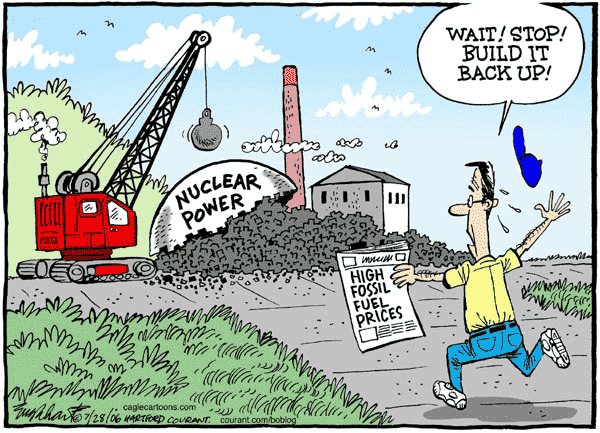Today I’ll be doing a short post on nuclear energy cartoons
and the general image they portray of the industry.
This cartoon focuses on the potential fallout in America
from the Fukushima disaster in 2011. The aftershock, being a smaller earthquake
occurring after the main one, is used metaphorically to depict the effects the
earthquake in Japan is having in the US. This would mainly be to increase fear
of earthquakes occurring in the US that could damage their own nuclear power
plants, especially in California which is sitting on a fault line. This has led
to activists calling for a review on energy policy and the potential stopping
of nuclear power expansion. These two comics (Japan + USA), although in a similar stream,
focus on the risks of building nuclear power plants near a fault zone, both in
the US and Japan.
| Aftershock of Fukushima (Nate Beeler 2011) |
This second cartoon illustrates how the decisive issue of
whether or not to build or use nuclear power plants are often made in snap
decisions depending on events occurring. This particular image displays how the
price of producing power is often a big influence, with its cost against the
traditional fossil fuels key; This potentially points to the fact that
governments only build nuclear power when it is a cheaper and more convenient
alternative, rather than actively trying to reduce carbon emissions as a main
goal. This linked comic also goes along the same theme of how quickly we are
influenced by disasters around the world, and how the public perception changes
through this.
 |
| Nuclear Plant Demolition ((NEI 2006) |
This third comic depicts the main issues with nuclear power,
being the lack of the ability to totally shutdown a nuclear power plant. This
is because, even when the induced nuclear chain reaction is halted, the natural
radioactivity of the fuel means further nuclear reactions still occur, which
means the fuel will need to be kept cooled for a long period of time after
shutdown. As evident in the Fukushima disaster, if the safeguards put in place
fail or are disrupted, there is very little that can immediately be done to
prevent the fallout of the continued nuclear reactions.
 |
| (Clay Bennett 2011) |
These final two comics refer to the longevity of the nuclear
waste produced, with the long decay time of the spent fuel and its
radioactivity in nature the big problems. Although not much can be done with
the waste in terms of time, which will be around for generations, there are
advancements in terms of storage which was lightly touched upon in my previous
blog about France.
 |
| Nuclear Waste (Mandy Hancock 2013) |
 |
| Nuclear Decay (BATR) |
No comments:
Post a Comment